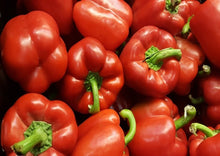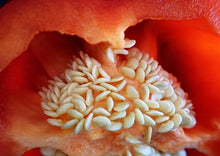A very thick-walled, average 4 1/2 to 5 inch size, four-lobed fruit are produced over an extended harvest period. Fruits turn from green to red as they mature.
This heirloom variety produces large bell peppers. Feed them with fish emulsion and you will be rewarded with bigger and higher yields.
Bell peppers (Capsicum annuum) are fruits that belong to the nightshade family. They are related to chili peppers, tomatoes, and breadfruit, all of which are native to Central and South America. Also called sweet peppers or capsicums, bell peppers can be eaten either raw or cooked. Like their close relatives, chili peppers, bell peppers are sometimes dried and powdered. In that case, they are referred to as paprika. They are low in calories and exceptionally rich in vitamin C and other antioxidants, making them an excellent addition to a healthy diet. Bell peppers come in various colors, such as red, yellow, orange, and green — which are unripe.
Green, unripe peppers have a slightly bitter flavor and are not as sweet as fully ripe ones.
Planting
- Recommended to start seeds indoors rather than in the garden.
- The soil temperature must be at least 70°F for seed germination, so keep them in a warm area for the best results. Use a heat pad under the seed tray, if necessary.
- Plant seeds about 1/4 inch deep.
- Start seeds indoors 8-10 weeks before your last spring frost date.
- Bell peppers require a fairly long growing season (60 to 90 days), so it’s best to get them started indoors.
- Bell Pepper plants require full sun to produce the largest and healthiest fruit, so pick a site that won’t get shaded out by trees or other garden plants.
- Soil should be well-draining and rich in organic matter.
- A soil consistency somewhere between sandy and loamy will ensure that the soil drains well and warms quickly.
- Soil pH should be slightly on the acidic side, 5.5 to 6.5 ideally.
- A week before transplanting peppers into the garden, introduce fertilizer or aged compost into your garden soil.
- Avoid planting peppers in places where you’ve recently grown other members of the nightshade family such as tomatoes, potatoes, or eggplants as this can expose peppers to disease.
Transplanting
- Begin to harden off plants about 10 days before transplanting outdoors.
- Once nighttime temperatures reach at least 60°F, transplant seedlings outdoors, space them 18” to 24” apart.
- Plant the transplants no deeper than they were already; otherwise, the stems may become susceptible to rot.
- Soil temperature should be at least 65°F, as peppers will not survive transplanting at temps any colder. Northern gardeners can warm up the soil by covering it with black plastic.
Care
- Soil should be well drained, but be sure to maintain adequate moisture either with mulch or plastic covering.
- Water one to two inches per week, but remember that peppers are extremely heat sensitive. If you live in a warm or desert climate, watering everyday may be necessary.
- Fertilize after the first fruit set. Peppers love fish emulsion, consider feeding once every two weeks.
- Weed carefully around plants to avoid disturbing roots.
- If necessary, support plants with cages or stakes to prevent bending. Try commercially available cone-shaped wire tomato cages.









